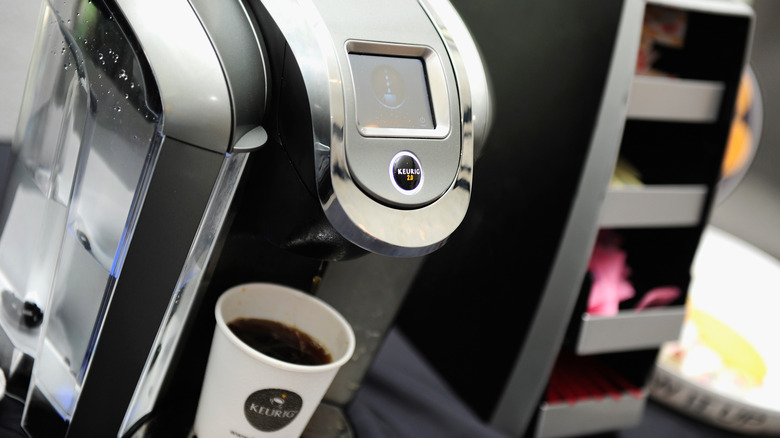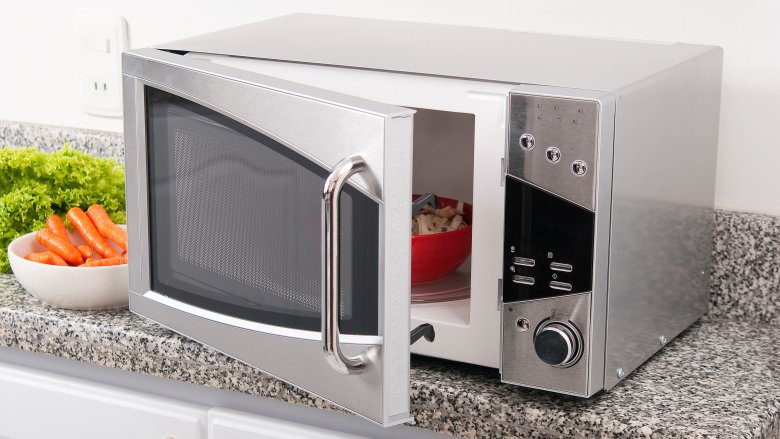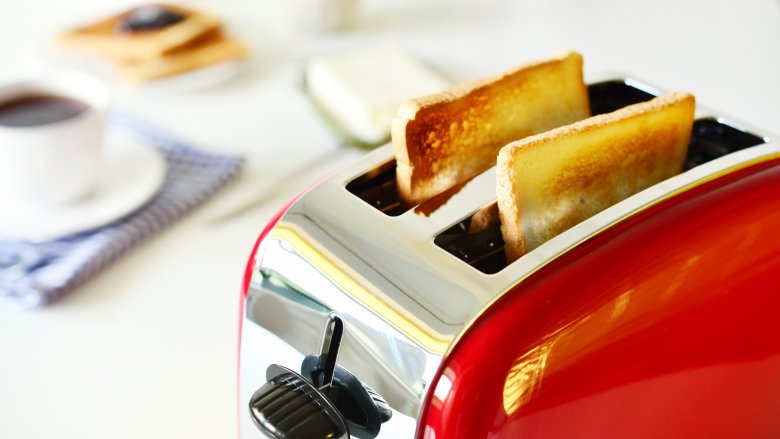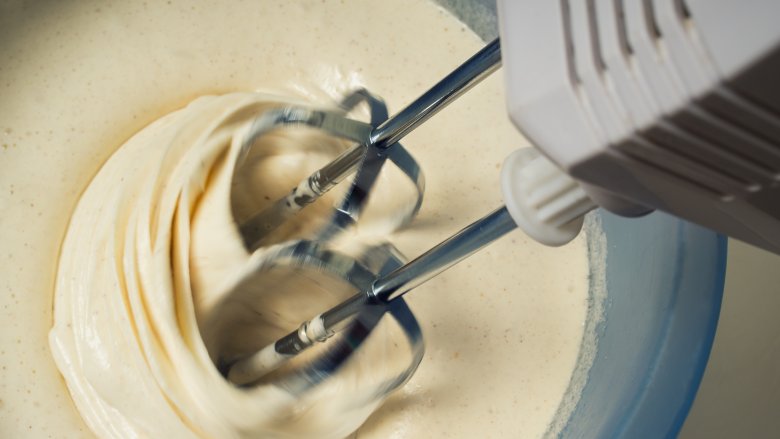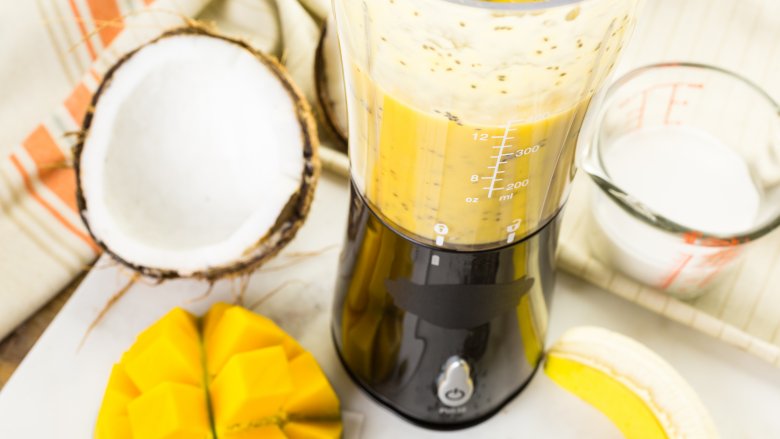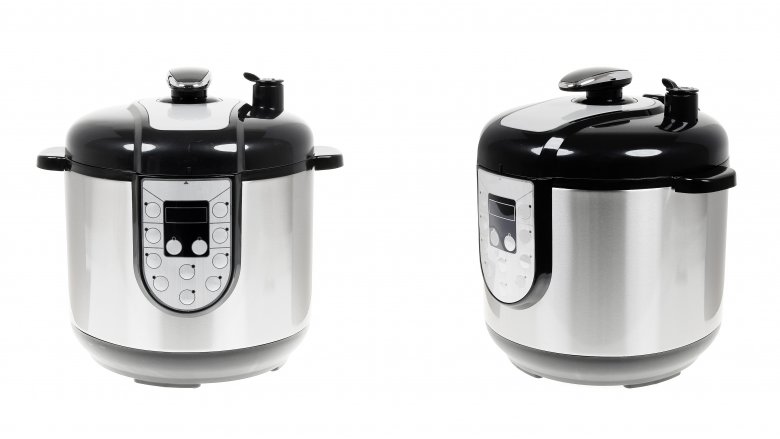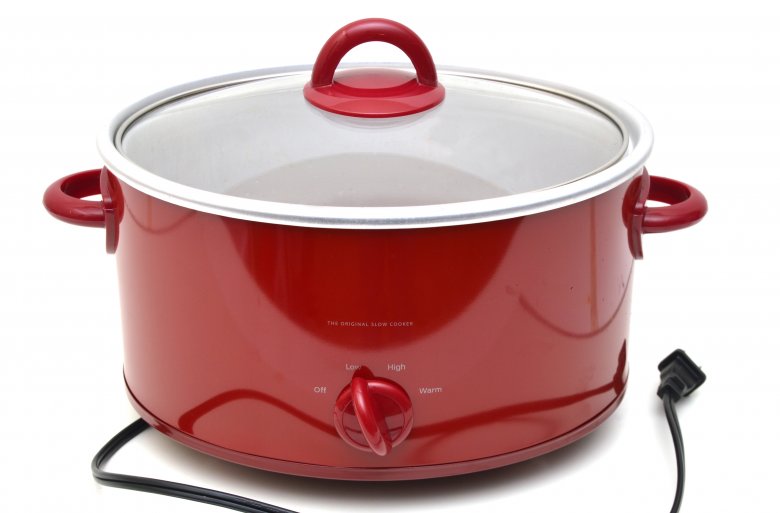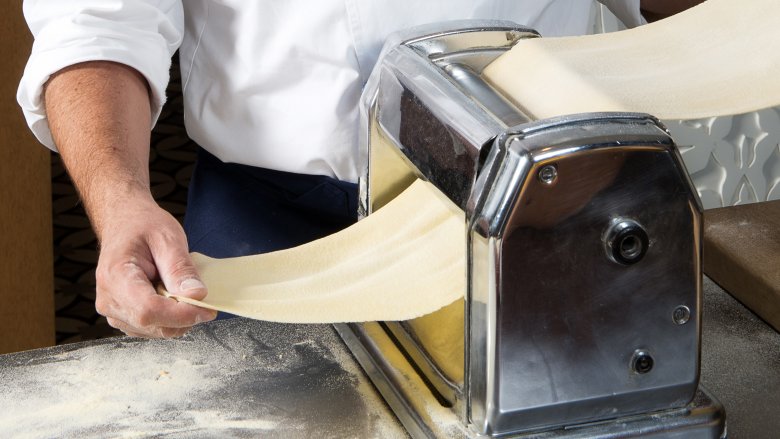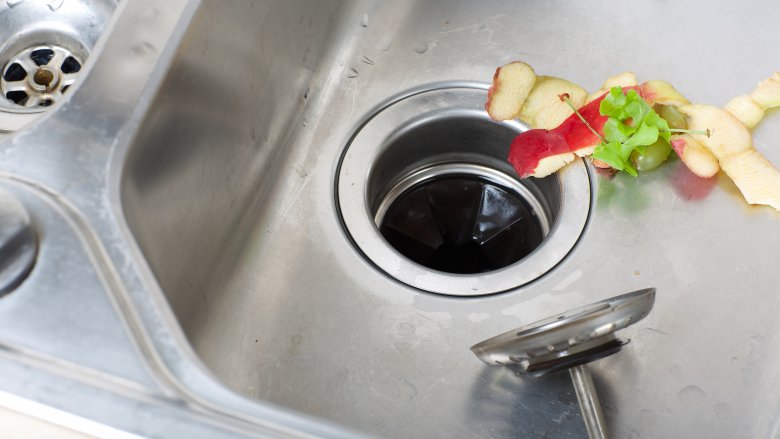Kitchen Appliances That Are Trying To Kill You
Scalding liquids. Hot pans. Sharp knives. The always-terrifying mandoline. Navigating the kitchen can sometimes feel like running a gauntlet of dangerous obstacles, and that's just performing the basics. So you glue pot holders to your hands. You practice your knife skills until you could successfully pass as an Iron Chef. And you use that blade guard like your life depends on it. You're feeling pretty smug, thinking you've beaten everything the kitchen can throw at you. But you've forgotten about the appliances...
Lurking in every corner is a contraption just waiting to either maim you or scare the bejesus out of you. Maybe it's just a small injury requiring some Neosporin and a bandaid. Perhaps it's worse and you're headed to the emergency room. Or maybe it's *only* a roach infestation that threatens to give you a heart attack. Whatever the case, thanks to exploding NutriBullets and creepy-crawlies living in your Instant Pot, you're in for a whole new kind of nightmare if you use of these appliances.
Keurig machines
K-cups and Keurig machines took the world by storm and we've never looked back, happily brewing individual cup after individual cup. If you're like most people, your daily routine probably involves topping off the water that's been in the reservoir since you bought the machine, popping in your pod, and enjoying your cup of joe minutes later. You probably don't take the time to clean the machine every few months, or even every year. Let's be honest — you probably never clean it. But your coffee tastes just as delicious as it always has, so what's the risk? Mold. Bacteria. Yeast. And, you know... ROACHES.
That's right. Everyone's least favorite insect — which can be carriers of intestinal diseases like diarrhea, dysentery, typhoid fever, and cholera — could be making their home inside your coffee maker. It's the perfect environment for cockroaches who love the dark, warm, and damp environment of the machine's water tank, which also happens to be the same environment mold, bacteria, and yeast prefer. So what do you do?
One Twitter user lamented, "There are tiny roaches living in our Keurig what do I do besides burn everything?" Honestly, that sounds reasonable to us. But before you chuck the whole thing, there's good news: You can rectify all these disgusting situations by simply cleaning and disinfecting the machine on the regular (and that goes for all coffee makers, not just Keurigs). It might a pain, but at least your morning cup will be roach-free.
Immersion blenders
Nobody can argue the handiness of an immersion blender. They save you the time of dragging out the big blender, and let you whiz up your sauces and soups right in their own pot. Another plus? They're super easy to clean... unless you forget to unplug it first.
The New York Times reported countless stories of home cooks slicing and dicing their fingers while trying to dislodge food from the blades of their immersion blenders, and that's because the power button has something of a hair trigger. It's just a little too easy to turn it on while handling it — and if it's plugged in, you're in trouble. According to Consumer Reports, more than 9,600 blender (both standard and immersion) injuries were treated in 2015, up from 7,000 in 2011.
But even in the face of lawsuits, Cuisinart spokesperson Mary Rodgers said the design is unlikely to change. "We've had discussions over the years about how maybe you could enclose the blade or something," she said, "but the way the blender functions, the food has to be sucked up to where the blade is, so that hasn't materialized." So the onus is on us: Don't touch the blades if the machine is running or plugged in. Or as Rodgers put it, perhaps a bit callously, "It's like anything else. If you have a knife and you aren't paying attention, not thinking about exactly what you're doing, if you touch it, you're going to get cut."
Microwaves
Every few years the warnings start flying around social media: "Don't ever microwave water in a cup by itself!" these messages plead. "It's a recipe for disaster that will surely lead to burns and permanent scarring when the superheated liquid explodes in your face!" Hyperbole? Maybe a little. But there is some truth here...
According to the FDA, "Overheating of water in a cup can result in superheated water (past its boiling temperature) without appearing to boil. This type of phenomena occurs if water is heated in a clean cup. If foreign materials such as instant coffee or sugar are added before heating, the risk is greatly reduced. If superheating has occurred, a slight disturbance or movement such as picking up the cup, or pouring in a spoonful of instant coffee, may result in a violent eruption with the boiling water exploding out of the cup." So yes, it can happen, but you have to have something of a perfect storm with ultra clean cups and water.
Bottom line? Play it safe. According to Steve Spangler Science, Dr. Gordon Lindberg, director of the burn unit at University of Colorado Health Sciences Center, warns, "These burns are dramatic and traumatic because they often affect the face and hands of the burn victim... The best way to avoid [them] is to place a wooden coffee stirrer in the liquid when heating it and also to let all heated liquids cool for a few minutes inside the microwave before removing them."
Toasters
As if roaches in your Keurig weren't enough, you've got to worry about your toaster now, too. Hey, cockroaches have to eat, and what better place than that bottom tray where a three-course meal of crumbs resides? Because, really, when was the last time you actually pulled that thing out and cleaned it? If you had you probably would have seen the roaches, who, don't forget, can be carriers of all those lovely intestinal diseases.
According to Any Pest, Inc., that tray is a common hiding place for those little buggers. If you want to keep them away you've got to keep the toaster clean, free of crumbs, and turn it on for three minutes (with nothing in it) to eliminate any scent of food. If they've already set up shop, Hunker recommends using the freezer to eliminate the pests. Just place the whole shebang in a sealed plastic bag, put it in the freezer for 24 hours, then shake vigorously and use a brush to dislodge any dead roaches.
But wait, there's more. Toasters are a fire hazard, too. ConsumerAffairs reports that the small appliance has a history of catching fire, due to both mechanical failure and an accumulation of crumbs in the bottom. They recommend keeping it clean, and unplugging it when not in use, just to be safe. And remember, if your toaster does catch fire, use a fire extinguisher, not water, or risk being shocked.
Electric mixers
How could an electric mixer be dangerous, you ask? Think about how tempting it is to stick a finger in the bowl while you're whipping up a batch of chocolate frosting. You get too close to those spinning beaters and next thing you know you're heading to the ER.
In a cringeworthy post on Cake Central, one unlucky baker warned, "Okay, so no one ever told me that baking was dangerous but last night I discovered that it is. I got my fingers caught in the beaters of my mixer. Ouch doesn't describe the pain I was in. It sliced two of my fingers and I was sure it had broken one of them. Thank goodness it wasn't a high-powered mixer or it would've taken my finger clean off."
And they're not the only one. From 1997 to 2010, Hospital-Data.com cataloged almost 9,000 hand injuries caused by an electric mixer, from lacerations to sprains and even fractures.
Fingers aren't the only concern when it comes to mixers — long hair is a real danger, too. Four-year-old Arabella Schraeder learned that the hard way when she got a little too close checking the progress of the batter she was making with her family. The beaters grabbed her long locks and pulled her forward, hitting her face against the bowl and swiftly removing a large swath of hair from her scalp. Thankfully, she suffered no long term injury, but it's a good reminder to keep your tresses back when baking.
NutriBullets
Anyone who's ever watched late-night television is familiar with the magical NutriBullet, and chances are good that you were sold on all its amazing smoothie-making abilities. But beware — there's one thing the infomercial might have forgotten to mention: Besides turning all your favorite frozen fruits and veggies into a deliciously nutritious puree, your beloved blender might also explode on you.
Dozens of people have claimed that while operating their NutriBullet — per the manual's instructions (meaning the ingredients were cold or room temperature, not hot) — the contents inside heated to a temperature high enough to cause the container to burst off its base. The explosion sent hot liquids flying, resulting in burns to the hands and faces of its unsuspecting users.
NutriBullet denied any wrongdoing in a statement — essentially blaming operator error — saying, "Reports of blenders, which have operated normally for years, suddenly turning cool ingredients into scalding hot mixtures after less than 20 seconds of normal operation are perplexing and contrary to the hundreds of millions of uses by satisfied NutriBullet customers worldwide."
Operator error or not, is any smoothie worth a potential trip to the emergency room?
Instant Pots
Say it isn't so. Everyone's favorite electric multicooker couldn't possibly have any flaws, could it? Buckle your seatbelts... this one's going to give you nightmares.
If you're like most people, you've fallen in love with the Instant Pot. After all, it can do just about everything. It can make breakfast, it can make dinner, it can even make yogurt. It can also grow maggots in its condensation collector. Yes, really. And if you don't know where the condensation collector is, you're probably in real trouble.
This plastic cup is meant to collect the water that runs off the lid when opened, keeping the mess from dripping onto your countertop. If it's doing its job, it's probably moist and warm and contains some bits of food, which makes it just the right breeding ground for maggots. Basically, if you aren't cleaning (and drying) the condensation collector thoroughly after each use, you're inviting maggots to come party in your kitchen. And that larvae, if ingested, can put you at risk of parasitic infections, gastrointestinal problems, food poisoning, and allergic reactions. So needless to say, it's probably best to keep them out of your Instant Pot.
Slow cookers
Thanks to This Is Us, you might already be a little hesitant about plugging in the slow cooker. In the now infamous scene, [spoiler alert!] a faulty Crock-Pot caught fire, burned down the Pearson house, and led to Jack's death. And it caused the masses to question the safety of their once favorite appliance. Crock-Pot quickly released a statement ensuring consumers that there was nothing to worry about, and that a faulty switch as portrayed in the show could not cause the unit to spontaneously combust. So, there's that.
But — there's always a but, isn't there? — there are other ways your slow cooker might pose a danger. Let's say you have an ancient machine handed down from generation to generation. Does it have a fabric cord? Toss it. Fabric cords are a fire hazard and don't meet today's safety standards. Frayed or broken cord? That's a short circuit waiting to happen.
Aside from potential fire hazards, an old slow cooker might not heat properly, leaving your foods in the danger zone when it comes to bacteria. According to the USDA, the temperature range of a functioning machine should be between 170 and 280 degrees. You can check your slow cooker's efficacy by filling it half full with water and running it for eight hours on low. If the water temperature isn't 185 degrees at that point, it won't cook your dinner safely, and that could lead to food borne illness. Time to toss it.
Pasta machines
Like electric mixers, you don't want to tangle with a pasta machine. Think of how effortlessly those rollers draw in big hunks of dough. Can you imagine getting a hand stuck in one? Unfortunately, Philadelphia chef Joe Cicala can. Hang onto your hats, because this one's a doozy.
Chef Cicala was making pasta at his restaurant, but the dough wasn't behaving — it was sticking to the rollers of the machine. Without thinking, he intervened. "So, like an idiot, I reached in and tried to force it through the machine. And then I just heard a crunch. Like a handful of popcorn exploded. It was so gross," Cicala said. After much effort, his hand was freed from the machine — by reversing the rollers, no less [shudder] — but all the bones of his fingers were crushed. He was rushed to the hospital for surgery to reconnect his fingers, and hopes further surgeries will reconnect nerves, though he was told his pinky may be forever numb. If this doesn't make a good case for store-bought pasta, we don't know what does.
Garbage disposals
Not only are humans at risk of injury in the kitchen... cats are, too. Humans, of course, are tempted to stick their hands into things they shouldn't, as we've seen demonstrated with mixer accidents, blender injuries, and pasta machine mutilations. Same goes for the garbage disposal. How many times, as something is clunking around in there, have you almost stuck your finger in to see what is was? Or maybe you actually did, and the result was a trip to the hospital. But what about cats? Cats, curious as they are, also like to stick their paws into the drain just like their owners. And apparently, they have been known to inadvertently turn on switches. Running disposal + paw in disposal = one unhappy kitty. The Humane Society actually recommends installing switch covers for their safety (oh, and probably for kids, too).
You also need to watch out for your disposal spitting metal bits at you. Almost 150,000 units were recalled in 2017 due to a possible malfunction that caused broken pieces to fly out of them. Maybe safety goggles are in order when running your disposal? Or maybe we just shouldn't go into the kitchen at all, ever again. Better safe than sorry, right?
